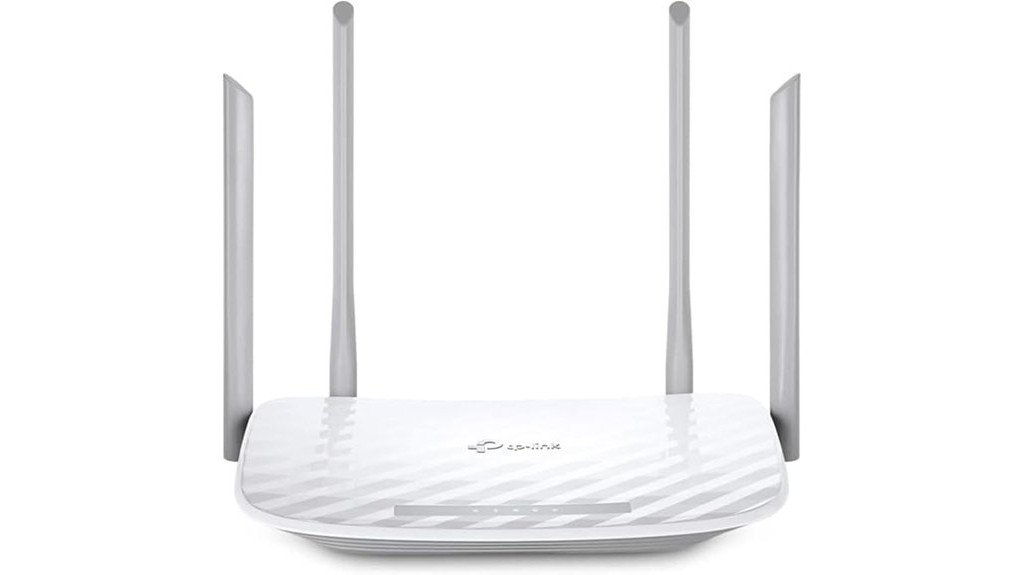The TP-Link AC1200 WiFi Router presents a balanced solution for home networking, merging dual-band capabilities with a top speed of 1200 Mbps. Featuring four external antennas, it promises reliable connectivity and expansive coverage. Equipped with WPA3 security and EasyMesh compatibility, it supports seamless network expansion. However, its lack of gigabit Ethernet ports may not suit high-demand users. Its manageable interface via the TP-Link Tether app enhances its appeal. What more lies beneath its surface?
Overview
The TP-Link AC1200 WiFi Router exemplifies a dual-band solution designed for users seeking a balance between performance and cost-effectiveness. It delivers a combined 1200 Mbps bandwidth, utilizing simultaneous 2.4GHz and 5GHz frequencies, catering to various networking demands. Equipped with four external antennas, it guarantees robust connectivity and expansive coverage. The router supports advanced networking protocols, such as IGMP Proxy/Snooping and VLAN tagging, optimizing IPTV streams. This device embodies a synthesis of affordability and technical prowess, appealing to those yearning for freedom from connectivity constraints without compromising on quality or breaking the bank. It stands as a reliable networking centerpiece.
Detailed Features
Building upon the foundational overview of its performance capabilities, the TP-Link AC1200 WiFi Router presents a suite of detailed features that enhance its utility and adaptability in various network environments. The dual-band router, offering 2.4GHz and 5GHz connections, guarantees a combined bandwidth of 1200 Mbps, optimized by four external antennas for expansive coverage. Its functionality extends with EasyMesh compatibility, facilitating seamless network expansion. Equipped with advanced security via WPA3, it guarantees robust cybersecurity. Additional features include Access Point Mode for transforming wired networks and IGMP Proxy/Snooping for IPTV optimization. Management is streamlined through the TP-Link Tether app, empowering user control.
Pros and Cons
Despite its robust set of features, the TP-Link AC1200 WiFi Router presents a mixed bag of strengths and weaknesses. On the positive side, its dual-band capability guarantees efficient bandwidth allocation, while four external antennas facilitate enhanced coverage. The inclusion of WPA3 security protocol underscores a commitment to cybersecurity. However, limitations arise with its 10/100 Mbps Ethernet ports, potentially bottlenecking wired connections. Additionally, advanced users may find the absence of gigabit support a drawback.
| Pros | Cons |
|---|---|
| Dual-band 1200 Mbps bandwidth | Lacks gigabit Ethernet ports |
| WPA3 advanced security | Potential wired connection bottleneck |
| EasyMesh compatibility | Limited advanced customization |
| Parental controls via app | Basic management interface |
Such insights empower informed decision-making.
Concluding Thoughts
While the TP-Link AC1200 WiFi Router offers a compelling blend of features for the average consumer, its technical limitations may deter users seeking high-end performance. It balances essential functionalities with cost-efficiency, yet lacks the cutting-edge throughput and gigabit ports desired by tech enthusiasts. Evaluating its position in the market reveals:
- Performance: Adequate for general use, but limited by 10/100 Mbps Ethernet ports.
- Security: Enhanced with WPA3, providing robust cybersecurity.
- Management: User-friendly via the TP-Link Tether app.
- Flexibility: EasyMesh compatibility and Access Point Mode cater to adaptable networking needs.
This router suits those prioritizing affordability over premium performance.
Frequently Asked Questions
How Do I Set up the Tp-Link AC1200 for the First Time?
To set up the TP-Link AC1200, connect it to a modem via Ethernet, access its web interface through a browser, and configure settings using the Quick Setup wizard. This process empowers users with efficient network autonomy and control.
Is the Tp-Link AC1200 Compatible With My Existing Devices?
The TP-Link AC1200 is broadly compatible with most existing Wi-Fi devices due to its dual-band capabilities. Supporting both 2.4GHz and 5GHz frequencies, it guarantees connectivity across a spectrum of gadgets, liberating users from connectivity constraints.
Can the Tp-Link AC1200 Handle Multiple Devices Streaming Simultaneously?
Coincidentally, the TP-Link AC1200’s dual-band capabilities, supporting 2.4GHz and 5GHz frequencies, efficiently manage simultaneous device streaming. Its 1200 Mbps total bandwidth guarantees robust performance, while four external antennas optimize coverage, liberating users from connectivity constraints.
Does the Tp-Link AC1200 Support VPN Connections?
The TP-Link AC1200 does not natively support VPN connections. Users seeking liberation from geographical restrictions may require third-party firmware like DD-WRT or OpenWRT, which can enable VPN functionality, enhancing privacy and bypassing internet censorship.
What Is the Warranty Period for the Tp-Link AC1200 Router?
The TP-Link AC1200 router features a two-year warranty period. This warranty guarantees protection against manufacturing defects, offering peace of mind to users seeking reliable network solutions. It underscores TP-Link’s commitment to product quality and customer satisfaction.

